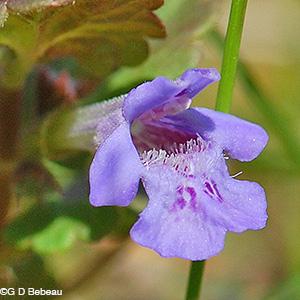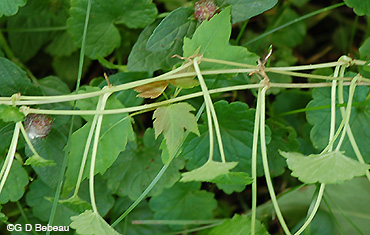The Friends of the Wildflower Garden, Inc.
Plants of the Eloise Butler Wildflower Garden
The oldest public wildflower garden in the United States

Common Name
Creeping Charlie (Ground Ivy, Gill-go-over-the-ground, Alehoof, Tunhoof, Field Balm)
Scientific Name
Glechoma hederacea L.
Plant Family
Mint (Lamiaceae)
Garden Location
Woodland
Prime Season
Late Spring to Early Summer Flowering
Creeping Charlie, or Ground Ivy, is an invasive perennial. Stems: It grows from a creeping stem, (square stem like most mints) which rises up from 1 to 16 inches, but is usually prostrate with only the flowering parts erect to show off its blue-purple 5 part flowers. The stem branches frequently and it can set roots near the axils of the leaves which allows the plant to form dense groupings.
Leaves are green to greenish-purple, opposite, long-stalked, round to kidney shape, with rounded coarse teeth (crenate) and a quite noticeable palmate vein structure. The underside of the leaf is dotted with glands. Both the upper leaf surface and the calyx of the flower are covered with fine fuzzy hair. Leaves are subject to attack by a leaf gall, Rondaniola bursaria. See photo below.
The inflorescence usually has 3 short-stalked flowers, 1/3 to 3/4 inch long, rising from the leaf axils. These repeat along the trailing stem.
Flowers: Flowers are tubular with a long narrow corolla that flares outward forming two lips. Two fused petals create the upper lip which is notched at the center and 3 petals join to form a lower lip, the center lobe large and 2 smaller side lobes. The corolla tube is 2 to 3 times as long as the green hairy calyx. There are 4 stamens arranged in pairs - 2 short and 2 long, a single pistil with a divided style, all of which tuck up under the upper lip. The throat of the flower has fuzzy hairs and the outside of the corolla has very fine hair.
Fruit: Each flower matures to four brown 1 seeded nutlets.
Habitat: Ground Ivy will be found growing in moist disturbed sites and lawns. While it accepts full sun, it prefers shade to partial shade. Small amounts can be controlled by hand pulling when the ground is moist; large infestations can be controlled or eliminated with broadleaf herbicides. Non-toxic corn gluten treatment is also said to be effective, but takes time. The plant has a somewhat rank balsamic odor and a bitter taste. Ground Ivy was frequently cultivated in former days. It makes a good ground cover, but is quite invasive in lawns, so it should be grown in controlled areas.
Names: The genus, Glechoma, is derived from the Greek word glechon, which describes a type of mint. The species, hederacea, means 'resembling ivy' and is derived from Hedera, the Latin name for Ivy. The author name for the plant classification, 'L.' is for Carl Linnaeus (1707-1778), Swedish botanist and the developer of the binomial nomenclature of modern taxonomy. In older literature you may find the plant listed as Nepeta hederacea. As to the other common names, Ground Ivy is self-explanatory from the plants creeping stems and multitude of green leaves. The use of the plant for clarifying beer in Saxon times (see notes at page bottom) produced the names 'Alehoof' and 'Tunhoof'. 'Gill-go-over-the-ground' derives from the same use but 'Gill' comes from the French 'Guiller', meaning 'to ferment beer'.


Above: The Flowering stems are held upright to expose the flowers while the main stem creeps along the ground. Illustration courtesy of Kurt Stüber's Online Library.
Below: 1st photo - The Flower corolla is much longer than the calyx. 2nd photo - The throat is bearded, note the fine hair on the corolla tube.


Below: 1st photo - The kidney shape leaf has a crenate edge. 2nd photo - The underside is pale and dotted with fine glands.


Below: 1st photo - A typical prostrate creeping stem of Ground Ivy. 2nd photo - Note the roots that form at each node.


Below: 1st & 2nd photos - Typical plants of Ground Ivy. 3rd photo - The leaves of Glechoma hederacea are attached by the gall midge, Rondaniola bursaria, whose larva feed on the leaf and the leaf cells form excess local growth to encase the larva. In late summer, these galls fall through the leaf to the ground where the insect overwinters.



Notes: Ground Ivy has been in the Garden since the beginning. Eloise Butler noted its presence in her log on Oct. 4, 1908. Martha Crone listed it on her 1951 Garden census. Both curators used the former botanical name Nepeta hederacea. Ground Ivy is a plant native to England that is naturalized across North America, found in all states except New Mexico, Arizona and Nevada; and in all the lower Canadian Provinces. In Minnesota it is found in about half of the counties, principally those in the eastern, wetter part of the state. Ground Ivy is the only species of Glechoma found in Minnesota.
Eloise Butler wrote: "Creeping Charley, who, with pretty, scalloped, round leaves and bright blue flowers, is not uncomely, if only he could be taught to keep his proper place. Various other rampant, naturalized plants, with pleasing foliage or flowers - Butter ‘n’ Eggs, Cypress Spurge, Aaron’s, Bouncing Bet - have been planted around him, which, together with the native goldenrods, will tussle with one another for possession of the field. We shall watch the scrimmage with somewhat, we fear, of the Irish delight in a shindy." Published Sept. 24, 1911, Minneapolis Sunday Tribune. The 1913 article about the Garden in The Bellman put it this way - "But he is avaricious; he aspires to be a great landed proprietor. Consequently he has been placed under the guard of Bouncing Bet (surely a militant suffragette), and other good plant police, including tansy, spurge, butter and eggs and catnip."
Practical use and Medicinal Lore: The glands on the underside of the leaves contain a volatile oil. In Saxon times for beer making before the use of hops, the leaves of ground ivy, steeped in the hot liquor, would clarify the beer. This also improved flavor and keeping quality and the process was used up to the time of Henry VIII. The plant has quite a history as it was endowed with curative powers, particularly for kidney diseases and for indigestion. Country people in England made a cooling beverage known as 'Gill Tea' from the leaves. Four glasses a day were the remedy for poor people who had a long-standing cough. In America it was used in a freshly made infusion by painters to counteract lead colic. The literature goes all the back to Dioscorides, whom Gerard quotes. See Mrs. Grieve (Ref. #7) for more detail. Culpepper (Ref. #4b) covers the same ground and adds more uses for the plant and adds his own note about the use in drinks: "It is good to tun up with new drink, for it will clarify it in a night that it will be the fitter to be drank the next morning; or if any drink be thick with removing or any other accident, it will do the like in a few hours." (Ref. Pg. 10 The English Physician Enlarged, London 1652, quoted from the 1810 reprint.)
Return to -- Site Plan/Archive Index --or-- List of Common Plant Names -- or -- List of Scientific Names -- or --Home Page - - - Back to top.
References: Plant characteristics are generally from sources 1A, 32, W2, W3, W7 & W8 plus others as specifically applied. Distribution principally from W1, W2 and 28C. Planting history generally from 1, 4 & 4a. Other sources by specific reference. See Reference List for details.
 Identification booklet for most of the flowering forbs and small flowering shrubs of the Eloise Butler Wildflower Garden. Details Here.
Identification booklet for most of the flowering forbs and small flowering shrubs of the Eloise Butler Wildflower Garden. Details Here.
©2014
Friends of the Wildflower Garden, Inc. Text and photos are by G. D. Bebeau unless otherwise credited. "www.friendsofeloisebutler.org"
030321